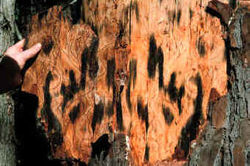| Ophiostoma | |
|---|---|
 | |
| Ophiostoma minus | |
| Scientific classification | |
| Domain: | Eukaryota |
| Kingdom: | Fungi |
| Division: | Ascomycota |
| Class: | Sordariomycetes |
| Order: | Ophiostomatales |
| Family: | Ophiostomataceae |
| Genus: | Ophiostoma Syd. & P.Syd. (1919) |
| Type species | |
| Ophiostoma piliferum (Fr.) Syd. & P.Syd. (1919) | |
| Synonyms | |
Ophiostoma is a genus of fungi within the family Ophiostomataceae. [2] It was circumscribed in 1919 by mycologists Hans Sydow and Paul Sydow. [3]
Note the former type species of Ophiostoma piliferum(Fr.) Syd. & P. Syd. (1919) is now Ceratocystis pilifera , Ceratocystidaceae family. [4]
The genus has a cosmopolitan distribution worldwide, except for central Asia, northern Africa and Russia. [1]